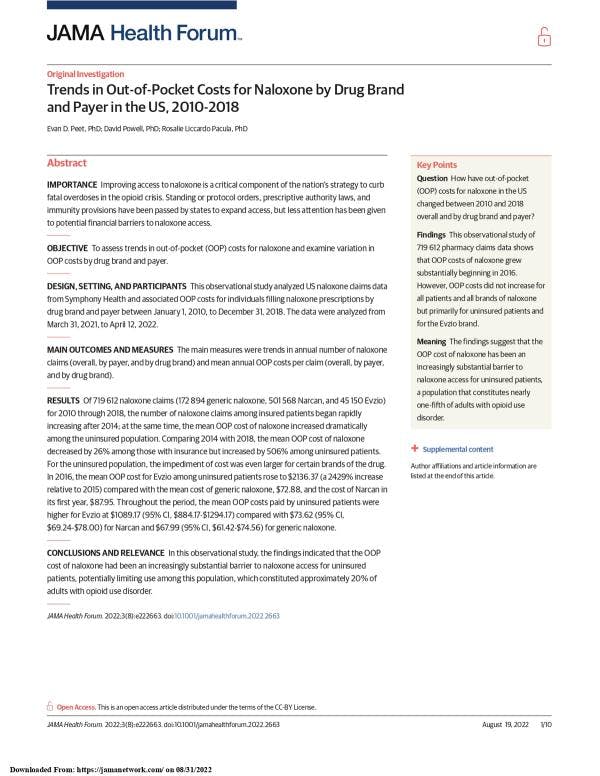Tendencias en costos no cubiertos para naloxona en los EE.UU., según marca de drogas y quién paga, 2010-2018
Peet et al. sugieren que el incremento de costo supone una barrera sustancial al acceso a naloxona para pacientes sin seguro. Más información, en inglés, está disponible abajo.
By Evan D. Peet, David Powell and Rosalie Liccardo Pacula
Improving access to naloxone is a critical component of the nation’s strategy to curb fatal overdoses in the opioid crisis. Standing or protocol orders, prescriptive authority laws, and immunity provisions have been passed by states to expand access, but less attention has been given to potential financial barriers to naloxone access.
This paper's objective was to assess trends in out-of-pocket (OOP) costs for naloxone and examine variation in OOP costs by drug brand and payer.
Of 719 612 naloxone claims (172 894 generic naloxone, 501 568 Narcan, and 45 150 Evzio) for 2010 through 2018, the number of naloxone claims among insured patients began rapidly increasing after 2014; at the same time, the mean OOP cost of naloxone increased dramatically among the uninsured population. Comparing 2014 with 2018, the mean OOP cost of naloxone decreased by 26% among those with insurance but increased by 506% among uninsured patients. For the uninsured population, the impediment of cost was even larger for certain brands of the drug. In 2016, the mean OOP cost for Evzio among uninsured patients rose to $2136.37 (a 2429% increase relative to 2015) compared with the mean cost of generic naloxone, $72.88, and the cost of Narcan in its first year, $87.95. Throughout the period, the mean OOP costs paid by uninsured patients were higher for Evzio at $1089.17 (95% CI, $884.17-$1294.17) compared with $73.62 (95% CI, $69.24-$78.00) for Narcan and $67.99 (95% CI, $61.42-$74.56) for generic naloxone.
In this observational study, the findings indicated that the OOP cost of naloxone had been an increasingly substantial barrier to naloxone access for uninsured patients, potentially limiting use among this population, which constituted approximately 20% of adults with opioid use disorder.
